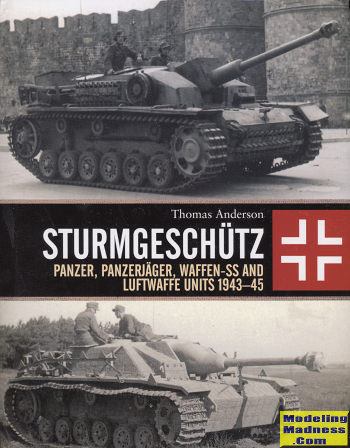 A
weapon that came into prominence with WWII and then pretty much disappeared
after it was the concept of the sturmgeschutz infantry support gun. Here was a
tracked vehicle whose main task was to support the infantry as moving artillery.
This was more than just a self propelled gun, but an 'almost tank' that would be
able to break through defenses such as pill boxes, and then move on to the next
task.
A
weapon that came into prominence with WWII and then pretty much disappeared
after it was the concept of the sturmgeschutz infantry support gun. Here was a
tracked vehicle whose main task was to support the infantry as moving artillery.
This was more than just a self propelled gun, but an 'almost tank' that would be
able to break through defenses such as pill boxes, and then move on to the next
task.
There were several benefits to these vehicles over a
standard tank, even if they carried the same armament. One was that they were
less expensive to build. By not having a turret, one could use the same chassis
as a standard tank, but not have the additional equipment. It was also a lot
lower to the ground than a tank. This made the StuG a superb ambush vehicle and
as the war progressed, a popular anti-tank gun.
However, its design also had its problems. Without a
turret, it could basically only attack what was in front of it. It could get off
a few shots then had to move away if pressured by standard tanks. It also was
unable to function properly in rough terrain. It was found to be useless in the
bocage country of northern France after the Allied invasion. Yet, it was very
popular with troops and with operators, with the design improving as the war
progressed.
In this book, the author continues from where he left
off in an earlier volume on this book and the units that operatedit. The last
one was pretty much its use in the regular army. This one concentrates on
panzer, panzerjaeger, Waffen-SS and Luftwaffe units from 1943 to 1945. In line
with the previous book, it takes a good look at not only
the operation and combat experiences of the vehicle, but also the way these
units were organized and how the stug was used. Unlike earlier in the war, these
were not under the control of artillery units, but were incorporated within
panzer units as well as being somewhat autonomous. Since this book covers the
last two years of the war, you'll find units in all the remaining fronts, not
just on the Eastern Front.
In addition to the great research done with this one,
there are a ton of superb photographs of the vehicles in action. It is this sort
of things that really gets most modelers inspired and adds a great deal to the
write-up itself. I like StuGs and learned quite a bit from this book. I am sure
that you will as well and have not problem giving this one my recommendation to
you.
February 2018
For more on the complete line of Osprey books,
visit
www.ospreypublishing.com.
If you would like your product reviewed fairly and fairly quickly, please
contact
me or see other details in the Note to
Contributors.
 A
weapon that came into prominence with WWII and then pretty much disappeared
after it was the concept of the sturmgeschutz infantry support gun. Here was a
tracked vehicle whose main task was to support the infantry as moving artillery.
This was more than just a self propelled gun, but an 'almost tank' that would be
able to break through defenses such as pill boxes, and then move on to the next
task.
A
weapon that came into prominence with WWII and then pretty much disappeared
after it was the concept of the sturmgeschutz infantry support gun. Here was a
tracked vehicle whose main task was to support the infantry as moving artillery.
This was more than just a self propelled gun, but an 'almost tank' that would be
able to break through defenses such as pill boxes, and then move on to the next
task.